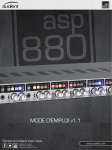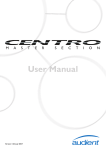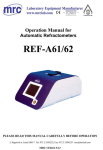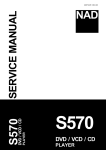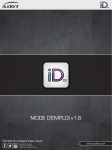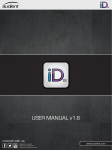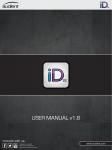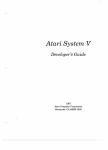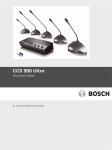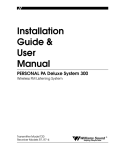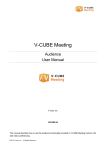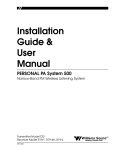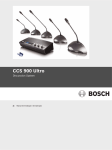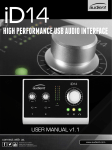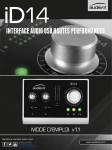Download USER MANUAL v1.0
Transcript
USER MANUAL v1.0 connect with us. facebook.com/audient twitter.com/audientworld youtube.com/audienthampshire .audient.com www.audient.com ASP880 | Contents Welcome & Thank You Thank you for purchasing this audient product! ASP880 can be seen as the natural progression of our classic ASP008 eight channel microphone preamplifier. Using the same proven discrete class-a 8-transistor input stage with extended bandwidth and a noise floor close to the theoretical Johnson noise limit, ASP880 provides a world-class recording front end in a convenient 1RU package. The microphone preamplifier has been refined over 15 years by design legend David Dearden and is the same tried & tested topology as featured in our consoles and recording interfaces (iD22, ASP8024, ASP4816). However we did not stop there with ASP880 - after months of refinement and an entirely new PSU design, we have been able to lower the noise floor in the unit and have reduced the 50Hz mains component to vanishingly low levels and the unit is completely silent (fanless operation) - impressive! On top of this we have used the cutting edge top-of-the-line Burr-Brown converters from our iD22 interface to heavily upgrade the digital card which now comes as standard! The unit is built like a tank and now features our custom, solid aluminium control knobs which feel great and provide excellent visual feedback. ASP880 will last for years to come! Box Contents1 ASP880 Overview3 Features include: Safety Information5 • 8 x superb class-a mic preamplifiers & 2 x discrete JFET instrument inputs Declaration of Conformities • Clean & stable P48 phantom power Hardware Features:9 • 60dB of clean gain with -10dB pads on channels 1 & 2 for kick, snare etc • Polarity reverse to enable phase coherent recording across all tracks • Variable input impedance providing a “triangle-of-tone”. Lo, med and hi settings allow you to voice your mic collection at the flip of a switch! • Super smooth 12dB/octave sweepable high pass filter (25 to 250Hz) to clean up low end rumble and mess! 7 Microphone & Line Inputs 9 Instrument Inputs10 Gain & Setting Levels 11 Input Signal Conditioning 12 Sweepable High Pass Filter 12 Variable Input Impedance 13 Analogue Line Outputs 15 Direct ADC Access & Inserts 15 AES Output16 ADAT SMUX Output16 Clocking - Setup and Wiring 17 ASP880 Block Diagram 19 Troubleshooting20 FAQ21 • New A-D insert switch provides line level direct access to converters for integrating outboard processing between the mic pres and ADC • Integrated Burr-Brown 115dB ADC with AES and SMUX ADAT outputs • Integrated fanless, low noise PSU with global operation Specifications22 Dimensions23 Warranty & Contact 24 Service25 Glossary26 Introduction Contents Box Contents In your ASP880 packaging you should find the following items: • ASP880 • Mains IEC Cable (in rear protection tube) • Quick Start Guide Please visit: www.audient.com/products/asp880/ downloads to get the latest version of the quick start guide and this manual. Watch/ listen to our example video content and grab useful things like a session recall sheet etc. SESSION: ____________________ ARTIST: ____________________________ TITLE: ____________________ DATE: __________ TIME: __________ NOTES: ____________________ ___________________________ ___________________________ ___________________________ ___________________________ ___________________________ A SOURCE: SAMPLE RATE: MIC: INSERT: CLOCK SOURCE: RECORDER INPUT: B SOURCE: SAMPLE RATE: MIC: INSERT: CLOCK SOURCE: RECORDER INPUT: C SOURCE: SAMPLE RATE: MIC: INSERT: CLOCK SOURCE: RECORDER INPUT: The integrated power supply in ASP880 will accept line voltages from 90 - 264V and can operate anywhere in the world without re-configuration - just use the appropriate mains IEC cable. We hope that you enjoy using ASP880 wherever you are and may it aid you in making great sounding music! 1 2 ASP880 Overview POLARITY REVERSE -10dB PAD 48V PHANTOM POWER Stable regulated supply for your mics ADC DIRECT ACCESS / INSERT Preserve your headroom on kick & snare drums so you can be sure everything is in-phase and as full sounding as possible Insert analogue gear between mic pre and ADC or use ASP880 as a standalone line level ADC SIGNAL / PEAK METERS +18dBu = 0dBFS Clip Indicators PEAK = -2dBFS SIG = -28dBFS SAMPLE RATE INDICATORS Sample rate switch = green when using external clock source, toggle through internal at 4 sample rates and then external sync POWER ON INDICATOR SWEEPABLE HPF DISCRETE JFET D.I INPUT Sounds fantastic on guitars & basses! VARIABLE INPUT IMPEDANCE 60dB of CLASS-A GAIN Clean, quiet & punchy! Bypassable, smooth 12dB/oct variable from 25 to 250Hz - clean up rumble and mud SOLID ALUMINIUM KNOBS TIP* roll them smoothly between your fingers for easy operation Triangle of tone for your mics! 200, 1400 or 3600 Ω DB25 ADC INPUTS MAINS SAFETY FUSE T1A Time Delay (replace with same type) BNC WORDCLOCK INPUT Hi-Z or 75Ω Termination available on rear panel switch DB25 ANALOGUE OUTPUTS Use to feed the mic preamps into outboard for processing Line level input direct to ADC to use as standalone A-D converter, or return outboard here to form an insert point (pressing the front panel A-D switch) XLR MIC / TRS LINE INPUTS Line inputs are available on combi jacks (padded into the mic pre) and have access to all input functions (except P48) MAINS IEC INPUT 90-264Va.c Operation anywhere in the world! AES or S/PDIF OUTPUT 9-Pin DSUB - format selected with rear panel push switch ADAT SMUX OUTPUT Top port 8 channels <48kHz Both ports 4 channels split >48kHz 3 4 Safety Information Safety Instructions Important Safety Instructions Important Safety Instructions Please read all of these instructions and save them for later reference before connecting the mains IEC power cable and powering up ASP880. To prevent electrical shock and fire hazard follow all instructions on the rear of the ASP880. 1. Read these instructions 2. Keep these instructions 3. Heed all warnings 4. Follow all instructions 5. Do not use this equipment near water 6. Clean only with dry cloth 7. Do not block any ventilation openings. Install in accordance with the manufacturer’s instructions 8. Do not install near any heat sources such as radiators, heat registers, stoves, or other equipment (including amplifiers) that produce heat 9. Do not defeat the safety purpose of the polarized or grounding-type plug. A polarized plug has two blades with one wider than the other. A grounding type plug has two blades and a third grounding prong. The wide blade or the third prong are provided for your safety. If the provided plug does not fit into your outlet, consult an electrician for replacement of the obsolete outlet 10. Protect power cords from being walked on or pinched particularly at plugs, conveniencereceptacles, and the point where they exit from the equipment 11. Only use attachments/accessories specified by the manufacturer 12. For products that are not rack-mountable: Use only with a cart, stand, tripod, bracket, or table specified by the manufacturer, or sold with the equipment. When a cart is used, use caution when moving the cart/equipment combination to avoid injury from tip-over 13. Unplug this equipment during lightning storms or when unused for long periods of time 14. Refer all servicing to qualified service personnel. Servicing is required when the equipment has been damaged in any way, such as power-supply cord or plug is damaged, liquid has been spilled or objects have fallen into the equipment, the equipment has been exposed to rain or moisture, does not operate normally, or has been dropped 15. For products that are a mains powered device: The equipment shall not be exposed to dripping or splashing and no objects filled with liquids (such as vases) shall be placed on the equipment ASP880 does not contain any user serviceable parts inside the internal power supply and in the event of a power supply failure, please contact audient support so that we can arrange suitable service. www.audient.com/support A 1RU ventilation space above the unit is recommended and it is not advised to run the unit in a rack above hot units such as valve outboard and multichannel AD/DA converters without suitable ventilation space around the unit. The internal switch-mode power supply design will accept any A.C line voltage from 90v to 264v @ 47-63Hz. Therefore the unit will work happily anywhere in the world but please ensure your A.C mains line voltage is within this specification and you use an appropriate cable for the region. Consult a qualified technician if you suspect difficulties. Do not attempt to tamper with the power supply or mains voltages - HAZARDOUS TO HEALTH. ! WARNING ! TO REDUCE RISK OF FIRE OR ELECTRIC SHOCK, DO NOT EXPOSE THIS APPARATUS TO RAIN OR MOISTURE. NO USER SERVICEABLE PARTS INSIDE. PLEASE REFER SERVICING TO QUALIFIED SERVICE PERSONNEL. 5 6 Declaration of Conformities We, Audient Ltd, declare that the product, the iD22, to which this declaration relates, is in material conformity with the appropriate CE standards and directives for an audio product designed for consumer use. Audient Ltd has conformed where applicable,to the European Union’s Directive 2002/95/EC on Restrictions of Hazardous Substances (RoHS) as well as the following sections of California law which refer to RoHS, namely sections 25214.10, 25214.10.2, and 58012, Health and Safety Code; Section 42475.2, Public Resources 7 FEATURES in in depth depth Hardware Features Microphone Preamplifiers & Line Inputs Discrete JFET D.I (Instrument) Inputs ASP880 features eight impeccably optimised class-a micprohone preamplifiers. ASP880 features two discrete class-a JFET D.I inputs (Channels 1 & 2). Plugging into these jacks will automatically select the D.I signal over the signals present at tha rear. Featuring a discrete 8-transistor front end, the mic pre is optimised for 0 to 60dB gain with an EIN (equivalent input noise) of -127.5 dB. The frontend has high-input headroom and will be happy to accept any level from your microphone collection, however for situations where you reach very hot signal levels such as drum recording, a switchable -10dB pad is included on channels 1 & 2 to provide a -10 to +50dB padded gain range. Why JFET? Junction Field Effect Transistors are known for their sweet tone and tube-like properties when overdriven. You will often find JFETs used in guitar pedals and such for this very reason. They sound good and “can” provide just a touch of sweetness and larger than life tone. JFETs also have a very high input impedance (often approx. 1012 Ω) and this makes them ideal for buffer circuits that do not load down the source device. Microphone inputs are provided on the rear panel using Combi XLR connectors - here the 1/4” Combi Jack connector provides a padded balanced line input (input impedance >10kΩ) directly into the mic pre stage. In the case of electric guitars or basses with vintage style passive pickups, the output impedance of the instrument can often be 6,000 to 40,000Ω, depending upon volume and tone pot positions. Typically we should provide a load that is 10 times the source to create a true bridging system. Therefore we need at least a 400kΩ load to get the most signal and tone from our instruments. It should then come as no surprise that most classic valve guitar amplifiers have a very high input impedance - 1MegΩ! These Combi Jack line inputs run through the mic preamp, providing a slightly sweeter tone (due to the 2nd and 3rd harmonic distortion in the mic pre) and have access to all input conditioning functions apart from phantom power. Please be aware that the input impedance switch functions as a variable pad for any line input signal (a secondary benefit!). 9 BY UST J E ON AT T IRECT! E R E G G IN D TUR CAP LUGGIN P We designed the JFET input on ASP880 to have a 1MegΩ input impedance and thus match the loading effect found on classic guitar amplifiers. This ensures you get the most tone from your instrument and when pushed the JFET circuit will provide plenty of 2nd and 3rd harmonic distortion (minimum 0.03% to lots!) ensuring that your instrument has a rich sound and some c o l o u r! 10 Hardware Features Setting Levels & Gain ASP880 has plenty of analogue headroom, running internally on +/-18V DC rails. Aim for -10dB FS peaks on the loudest s when setting ections gain & record ing levels in th e DAW! The unit can deliver up to +27.5dBu at the analogue output DB25 on the rear of the unit. 2. 3. 4. 5. P48 Phantom Power -10dB Pad (channels 1 & 2) Polarity Reverse Sweepable High Pass FIlter P48 Phantom Power Phantom power can be supplied on a per channel basis by pressing the P48 switch (1). This is supplied at 48V +/-4v @ 10mA per channel and is fully compliant with the DIN45596 specification. This is suitable for any phantom powered condenser mics, or ribbons with on-board active head amps etc. In this case, the ASP880 has a digital lineup reference of +18dBu = 0dBFS (full scale), therefore the analogue circuitry will have anywhere from 4 to 9.5dB headroom above digital maximum (don’t worry about it!). To do this, adjust the gain knob on ASP880 whilst observing the metering in your interface or DAW application. 1. In order to correctly condition input signals, ASP880 provides the following functions: • • • • However it would be typical in modern digital recording situations that ASP880 is using our own internal pristine 115dB ADC converters to produce a digital output for recording via AES or ADAT digital output. As a target guide, we would recommend that you turn up the ASP880 gain pots to produce a -10dBFS peak signal level in your DAW when recording. This will maintain plenty of headroom and things often sound better in the DAW if you record with lots of headroom. Input Conditioning -10dB Pad The 10dB pad (2) can be used in conjunction with the gain control to adjust any hot signals on channels 1 & 2. Please note that the actual attenuation value of this pad will vary with micpre input impedance (lo, med or hi) and therefore using your ears and eyes is the best policy here! The hardware metering on the ASP880 will show signal present at -28dBFS (-10dBu) and will warn of potential overloads at -2dBFS (+16dBu) however you should rely upon the recording destination for accurate metering. 11 ø Polarity Reverse Polarity reverse (180 degrees) can be applied to any channel to ensure that multi-mic setups sound as full as possible. ALWAYS REMEMBER TO CHECK PHASE. To check phase coherency on multi-mic setups, first always use careful microphone placement and then press the ø switch (3) on various combinations of channels to find the fullest, most solid low frequency representation of the source. On drum kit recordings typically you may find either the kick drum out of phase with the overheads, or the underneath snare mic out of phase with the top snare mic etc. Sometimes, one overhead is out of phase with the kick drum, so move mics first and then use the polarity reverse switch to find the best compromise. Sweepable High Pass Filter The sweepable HPF is 2nd order 12dB per octave and can be used to increase headroom and clean up low frequency rumble etc. Engage this by pressing the switch (4) and adjusting the frequency control (5). 12 Hardware Features Variable Input Impedance One stand-out feature of the ASP880 is the variable input impedance (Z) control. There are three impedance load settings on the unit, and these can be used to extract various voicings from your mic collection by loading the mic’s output stage differently. Notably mics with transformer outputs such as SM57 / SM7 dynamic mics or Coles 4038 ribbon microphones often provide quite noticeable changes in tone when operated into various loads. The source (microphone) and load (mic preamplifier) form a bridging voltage divider, that contain different values of resistance for the source at different frequencies - thus creating a varying frequency response (or different output levels for each part of the SM57 impedance curve) and thus a change in tone can be perceived. 200 Ω 1400 Ω 3600 Ω Listen for the following: PRE - LOAD 200 Ω 1400 Ω 3600 Ω If in doubt, consult your microphone datasheet & manufacturer. FAST DETAILED GND Take the dynamic output impedance of an SM57 for example (illustration only): Please be aware that some microphone types (transformerless condensor types) may not produce audible changes due to their electronically buffered output stages which have linear output impedances with regards to frequency and therefore are less susceptible to changes in loading. OUT The three settings on ASP880 are: • LO • MED • HI When listening, this diagram may come in helpful if trying to train your ear to hear the differences. 1. Change in Level 2. Change in Speed (Transient Response) 3. Change in Tone (Frequency Response) 4. Change in Detail MIC - SOURCE 310 Ω @ 1kHz Varying at all frequencies IN Variable Input Impedance - Listening Typically there is some change in level, timbre, punch and tone when changing Z. Ribbon mics are known for liking HI-Z inputs. HI MED SOFT HARD -20 2k LOAD = 3600 Ω LO LOAD = 1400 Ω dB Ω LOAD = 200 Ω GLUED 310 Ω 0 20 Hz ∞ 20 Hz SLOW 20k 20k 13 14 Hardware Features Analogue Line Outputs Digital Outputs - AES - S/PDIF ASP880 features 8 analogue, cross-coupled line driver outputs on DB25. These fully balanced outputs use the same circuitry as our proven ASP8024 flagship console and provide “transformer-like” differential line drive and high headroom with a sturdy, transparent pair of operational amplfiiers. The on-board digital card in ASP880 can provide both double speed (96kHz) AES and ADAT output signals. 1. The AES output is available on a 9-pin DSUB connector and is fully transformer balanced according the AES specification. The 9-pin DB9 connector provides eight channels of balanced AES digital output and the wiring pinout is as shown to the right. Use these outputs to use ASP880 as a standalone eight channel analogue mic pre. These outputs are wired as Tascam DB25 standard with 100Ω output impedance and +27.5dBu maximum level. Pressing the AES - S/PDIF switch (1) will switch the DB9 output stage into consumer format (lower signal amplitude etc) for S/PDIF operation. In most cases, you will likely be using the AES professional output so this switch can remain in the out position until required. AD Converter Direct Access / Inserts ADC balanced line inputs are available on a rear panel DB25 connector (also Tascam format). You can use these to directly access the AD converter with +18dBu input headroom (0dBFS = +18dBu) for line level signals, allowing you to feed the ADC from other sources such as alternative mic pres etc. However this also provides a path in which you can insert processing outboard such as EQ & compression between the mic pres and ADC - useful!! Digital Outputs - ADAT SMUX The digital card also provides simultaneous ADAT optical output on the rear of the unit with full SMUX double speed capability. ASP880 & iD22 - Perfect Harmony Combining ASP880 with our iD22 USB recording interface via ADAT - you get 10 audient mic preamps, 10 top-of-the-range Burr-Brown AD converters and 6 pristine DAC outputs for monitoring! Nice! For <48kHz operation, a single optical cable should be connected from the top (1-4) ADAT port. This will provide 8-channels @ 48kHz. For >48kHz operation, two optical cables should be used, with four channels carried on each for full 8ch 98kHz operation. To activate the direct AD access press the front panel A-D switch on each channel. 15 16 Hardware Features Clocking with the ASP880 Slave Clock Operation - EXTERNAL There are two ways to integrate ASP880 into your system digitally: You may have a studio master clock source such that all digital devices synchronise to your session sample rate, or perhaps you would like the ASP880 to follow your DAW/ recorder session sample rate so that you do not have to reconfigure the unit when you flip between sessions at different sample rates. • As a MASTER clock source - internal clock • As a SLAVE device - external clock Master Clock Operation - INTERNAL 1. Assuming that you are connecting the ASP880 digital output to a DAW/recording interface with either AES or ADAT inputs, the ASP880 can be set as MASTER clock source as follows: In order to do this, you must set the ASP880 digital card to SLAVE to an external clock source. Press the SAMPLE RATE switch (1) until it is flashing green (external clock mode). Select the appropriate sample rate on the front of ASP880 by pressing the SAMPLE RATE switch (1). Ensure that your DAW/recorder session is set to the same sample rate and that clock source is set to external digital input (either AES or ADAT). CONNECT DIGITAL OUTPUT (AES or ADAT) TO YOUR DAW/RECORDER MASTER CLOCK SOURCE BNC OUTPUT 2. 3. 75Ω COAX CABLE Ensure that your master clock source is connected via a 75Ω coaxial BNC cable to the Word Clock input on ASP880 (2) - with a valid clock signal present here, the green LED in the SAMPLE RATE switch should become solidly lit, indicating external lock. If ASP880 is the only or last device in the clock chain fed from the master clock, go ahead and press the 75Ω termination switch (3) to ensure that the clock line is loaded properly to stop any transmission line effects. Your DAW/recorder should automatically follow the sample rate set on the front of the ASP880. Note that both the AES and ADAT output simultaneously so you can feed a backup recorder at the same time on location gigs! 1. CONNECT DIGITAL OUTPUT (AES or ADAT) TO YOUR DAW/RECORDER If using a BNC T-Bar to distribute clock signals to various devices - please ensure the last device in the chain is terminated (75Ω). 17 18 ASP880 Block Diagram Troubleshooting & FAQ Troubleshooting FAQs • My microphones are not producing signal? For more information and service information / support, please search our online Knowledge Base which can be found here: www.audient.com/support Double check that phantom power is turned on via the front panel switch, try swapping XLR cables, then double check all connections to the recorder. • I cannot clock the ASP880 from an external clock source, or you are experiencing clicks & pops? Double check that you have set the clock source to external by using the front panel SAMPLE RATE switch, press it until it is flashing green. This selects external clock mode. For technical support please create a ticket in our online support system, Zendesk which can also be found in the support section of our website (see link above). From here, double check your master clock source, and ensure it is connected via a 75Ω BNC coaxial cable to the ASP880 BNC wordclock input. Providing that you have a valid clock source, ASP880 should sync to it without issue and the SAMPLE RATE led in the switch will turn to solid illumination. This shows that the unit is locked. If you experience pops & clicks double check any master/slave device configurations and cabling. A system should only have one master clock. 19 Please consult the warranty statement on page 23 for further information regarding service requirements and our policies. 20 Specifications Dimensions 321mm MICROPHONE PREAMPLIFIERS: (measured to insert send) ADC LINE INPUTS (Insert Returns): *Line input level at the combi jacks will be affected by the input impedance switch position, this can be used as a second pad control to adjust line input ranges on all channels. MAXIMUM INPUT LEVEL: +18dBu 0dBFS = +18dBu DIGITAL REFERENCE LEVEL: INPUT IMPEDANCE: >10kΩ Balanced FREQUENCY RESPONSE: +/-0.5dB 10Hz to Fs/2 CROSSTALK: <-80dBu @ 1kHz & 10kHz <0.002% (-94dB) THD+N @ -1dBFS (1kHz): THD+N @ -6dBFS (1kHz): <0.002% (-94dB) 113dB un-weighted DYNAMIC RANGE: 115dB A-weighted PEAK LED LINEUP: +16dBu (-2dBFS) -10dBu (-28dBFS) SIGNAL LED LINEUP: ADAT 8 CHANNELS SMUX: AES | S/PDIF 8 CHANNELS: CLOCK: WORDCLOCK INPUT: 44.1 - 96kHz 44.1 - 96kHz Internal or External 75Ω BNC Optional 75Ω Termination 440mm DIGITAL i/o: 482mm XLR: Pin 2 (Hot), Pin 3 (Cold) & Pin 1 (Shield) 1/4” JACK: TIP (Hot), RING (Cold) & SLEEVE (Shield) (measured at AES output under AES-17) 280mm MIC GAIN: -10 to +60dB (-10dB Pad) LINE GAIN: -16 to +44dB (-10dB Pad)* PHANTOM POWER: 48v +/-4v @ 10mA/Channel MIC EIN:<-127.5dBu CMRR: >80dB @ 100 to 10kHz +22dBu (+32dBu with Pad) MAXIMUM INPUT LEVEL: INPUT IMPEDANCE Mic LO: 200Ω Balanced Mic MED: 1k4Ω Balanced Mic HI: 3k6Ω Balanced Line (All Z): >10kΩ Balanced +/-0.5dB 10Hz to 100kHz FREQUENCY RESPONSE: <-85dBu @ 1kHz & 10kHz CROSSTALK: THD+N @ 0dBu (1kHz): 0.003% (-90.5dBu) SNR: >90dB Sweepable from 25Hz to 250 Hz HPF: 2nd Order (12dB/Octave) POWER SUPPLY: DISCRETE JFET D.I (Channels 1 & 2): (measured to line outputs / insert send) High stability, low noise internal SMPS Fanless, quiet operation Works anywhere in the world without reconfiguring D.I GAIN: -10 to +60 dB (-10dB Pad) MAXIMUM INPUT LEVEL: +16dBu (typical), +22dBu 1MegΩ Unbalanced INPUT IMPEDANCE: FREQUENCY RESPONSE: +/-0.5dB 10Hz to 50kHz THD+N @ 0dBu (1kHz): <0.03% (-70dBu) SNR: 89dB LINE VOLTAGES: INTERNAL RAILS: FUSE: CONSUMPTION: 90 to 264V (a.c) +/-18VDC, +48VDC & +5VDC T1A (1Amp Time Delay) Maximum 40 Watts WEIGHT: 4.0 kg 1/4” JACK: TIP (Hot) & SLEEVE (Shield) +27.5dBu <100Ω Balanced 44.4mm MAXIMUM OUTPUT LEVEL: OUTPUT IMPEDANCE: 21 3mm LINE OUTPUTS (Insert Sends): 22 Warranty Service Warranty Statement Service Information Your ASP880 comes with a manufacturer’s warranty for one year (12 months) from the date of despatch to the end user. ASP880 contains no user-serviceable components, please refer to qualified service personnel for diagnosis and repair. Your warranty will be void if you tamper with the device at component level. If you have any questions with regard to the repair, please contact Audient Ltd. The warranty covers faults due to defective materials used in manufacture and faulty workmanship only. During the warranty period audient will repair at its discretion or replace the faulty unit provided it is returned carriage paid to an authorised audient service centre. We will not provide warranty repair if in our opinion the has resulted from unauthorised modification, misuse, negligence or accident. We accept liability to repair or replace your ASP880 as described above. We do not accept any additional liability. This warranty does not affect any legal rights you may have against the person who supplied this product - it is additional to those rights. In the event your ASP880 needs to be repaired, it is necessary to contact Audient Ltd prior to shipping, and a Return Materials Authorization (RMA) number will be assigned. This number will serve as a reference for you and helps facilitate and expedite the return process. When the unit is returned please include this RMA number along with a description of the fault inside the packaging box. Audient requires that shipments be pre-paid (for in-warranty repairs we will cover the return shipping). To request an RMA, access technical support & FAQs, ask for troubleshooting assistance or make an enquiry, please visit: www.audient.com/support Warranty Limitations This warranty does not cover damage resulting from accident or misuse. The warranty is void unless repairs are carried out by an authorised service centre. The warranty is void if the unit has been modified other than at the manufacturer’s instruction. The warranty does not cover components which have a limited life, and which are expected to be periodically replaced for optimal performance. We do not warrant that the unit shall operate in any other way than as described in this manual. Audient Ltd Aspect House Herriard Hampshire RG25 2PN United Kingdom Tel: 0044 1256 381944 www.audient.com 23 24 Glossary A ADAT ADC AES ASP DAW DAC dB dBu dBFS DB9 DB25 DC D.I DoC EIN FAQ HPF HV Hz i/o JFET LED Ohm RoHS S/PDIF SMUX THD+N TRS TS USB V XLR Z Amperes Alesis Digital Audio Tape Analogue to Digital Converter Audio Engineering Society - AES Digital Audio Format Analogue Signal Processing Digital Audio Workstation Digital to Analogue Converter Decibel Decibel referenced to 0.775Vrms = 0 dBu Decibel Full Scale 9-Pin DSUB Connector - Digital AES Format 25-Pin DSUB Connector - Analogue Tascam Format Direct Current Direct Injection (Instrument Input) Declaration of Conformity Equivalent Input Noise Frequently Asked Questions High Pass Filter High Voltage Hertz, cycles per second - measurement unit of frequency Input / Output Junction Field Effect Transistor Light Emitting Diode Ω, Unit of Resistance Restriction of Hazardous Substances Sony Philips Digital Interconnect Format Sample Multiplexing Total Harmonic Distortion + Noise Tip Ring Sleeve (1/4” Jack Balanced) Tip Sleeve (1/4” Jack Unbalanced) Universal Serial Bus Volts Extra Live Return, Extremely Low Resistance, Canon X Series, Latching, Resilient Rubber Compound... or make up your own! Ohms, Ω, Input Impedance - can be varied by adjusting Z switch 25 USER MANUAL v1.0 February 2014 connect with us. facebook.com/audient twitter.com/audientworld youtube.com/audienthampshire .audient.com www.audient.com















